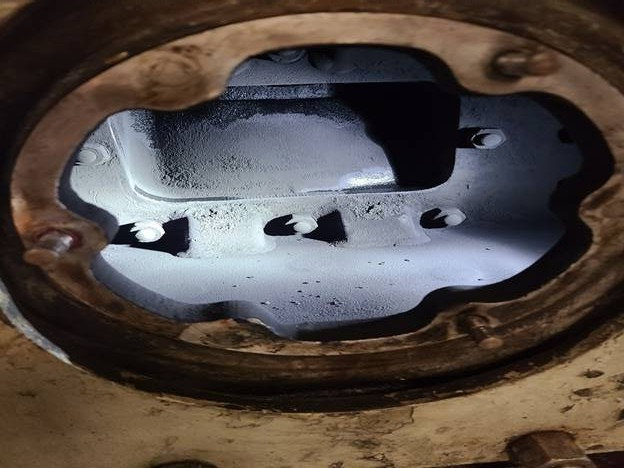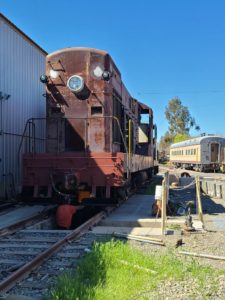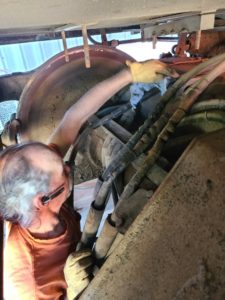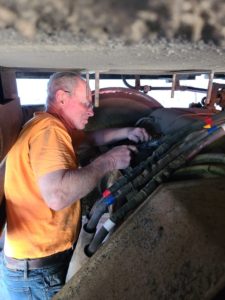Diesel Service Report, March 14, 2022
SP1006 SW1 Repair
The locomotive was reported to not being able to move. The term for that is “Not Loading”. John Stumreiter tracked the problem down to a loose contact and other issues on the ground fault relay. Once they were repaired, the problem was solved.
SF560 Fairbanks Morse H12-44 Restoration Status
The locomotive was again connected to the load bank for the second time. It was operated at 900 HP and everything ran correctly. A couple days later, one exhaust manifold inspection cover was removed to see what the manifold looked like in the inside after operating at high power levels.  It was perfectly gray as expected. There was some slight wetness from oil that had wept down from the upper cylinder rings and whetted the input to the manifold. That was expected.
It was perfectly gray as expected. There was some slight wetness from oil that had wept down from the upper cylinder rings and whetted the input to the manifold. That was expected.
The load test was the last task that John Salvini and Richard Berk had lined up for the engine. The Diesel engine is now considered operational. However, we know that special operating procedures will need to be developed in order to run the locomotive and not have it spit oil out the exhaust. Those procedures will be based on using the load back in order to operate the engine at high power levels to keep the exhaust system clean of liquid oil.

What we don’t know yet, is how many hours we can operate at low power settings before having to put it back on the load bank. We will determine that after the locomotive is put into museum service.
Our next task will be to remove the trucks from under the locomotive and inspect, clean, and repair as necessary. Before that can be done, the traction motor leads needed to be disconnected from the locomotive. That work was done using the pit by Carbarn 4.
 Carl Pickus and Frank Kunsaitis accomplished disconnecting the leads last Saturday. The leads on three of the motors were in good shape with just some caked on dirt. The fourth motor had its leads directly under a hole in the engine room sump. Oil from the sump had made a real mess in that area. Notice that the leads are connected with bolts, rather than the EMD style glad hand clasps. Frank removed a lot of the dirt before opening the joints to access the bolts.
Carl Pickus and Frank Kunsaitis accomplished disconnecting the leads last Saturday. The leads on three of the motors were in good shape with just some caked on dirt. The fourth motor had its leads directly under a hole in the engine room sump. Oil from the sump had made a real mess in that area. Notice that the leads are connected with bolts, rather than the EMD style glad hand clasps. Frank removed a lot of the dirt before opening the joints to access the bolts.
Carl then used different colored tapes on the leads to make certain that they are reconnected correctly when the trucks go back under the locomotive.
At the end of the day, the locomotive was put back into Carbarn 7, ready for the truck removal which should start next Saturday.
There are a couple of options for removing the trucks. One is to jack the locomotive high enough to remove just the rear truck. The second approach is to jack the locomotive high enough to remove both trucks.
If just the rear truck is removed, cribbing under the locomotive frame has to be placed where the rear truck was and another set of cribbing has to be placed on top of the front truck up to the locomotive frame side bearings. Then when the rear truck is ready to be installed, all the cribbing needs to be removed, the truck shoved back under the locomotive. The locomotive has to be lowered back onto the trucks. Then the locomotive has to be turned on the wye. Then repeat the process for the front truck.
If both trucks are removed at the same time, then two sets of cribbing will be needed from the floor to the locomotive frame. The cribbing won’t need to be rebuilt a second time and the locomotive won’t need to be turned.
That decision will be made as the locomotive is jacked up for the first time. If it looks like it will be easy to jack the locomotive high enough to remove both trucks then that’s what we will probably do. But if jacking high enough becomes a problem, then we will work on one truck at a time.
After the trucks are removed, the task will be to refurbish them, hopefully without having to remove traction motor and wheel assemblies. We already know that there are bent straddle bars, which is to be expected after working in a junkyard for many years. But we won’t know what else is wrong until the trucks are removed from under the locomotive.
The biggest task, both for the trucks and the rest of the locomotive, is to clean everything. There is caked on dirt and oil that is so hard that it will require a needle gun or hammer and chisel to remove it. That will require months of work.
An inspection of the paint in the cab has been completed. The original color was dark green, exactly like we found in the cab of SP1006. Everything, other than the floor, was painted in that color. The individual brake portions, bell valve, and sander valve, will be painted black. The floor will be finished with a rust colored very thick material called “Battleship Linoleum”. We have samples of it and have a supplier in Escondido. The flooring material will be the last thing to do in the cab.
The windows in the cab will all be replaced after all painting is done on the locomotive.
– Dave Althaus

